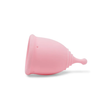Menstrual cups have gained significant popularity in recent years as a sustainable and cost-effective alternative to traditional menstrual products. If you're considering making the switch to a menstrual cup, there are a few key things you should know. In this guide, we'll cover seven important aspects of menstrual cups to help you understand their benefits and how to use them effectively.
-
What is a menstrual cup? A menstrual cup is a reusable bell-shaped cup made from medical-grade silicone, rubber, or latex. It is designed to be inserted into the vagina to collect menstrual fluid during your period. Unlike tampons and pads, which absorb menstrual flow, menstrual cups simply collect it.
-
How do menstrual cups work? To use a menstrual cup, you fold it and insert it into your vagina, where it unfolds and creates a seal against the vaginal walls. The cup collects menstrual fluid, and you can wear it for up to 12 hours before emptying and rinsing it. After emptying, you can reinsert it.
-
Benefits of using menstrual cups:
- Environmentally friendly: Menstrual cups produce less waste compared to disposable tampons and pads.
- Cost-effective: While the initial cost of a menstrual cup may be higher, it can last for several years, saving you money in the long run.
- Extended wear time: Menstrual cups can be worn for up to 12 hours, offering longer protection than tampons or pads.
- Comfortable and convenient: Once properly inserted, menstrual cups are generally not felt, unlike tampons, which can cause dryness or discomfort.
- Fewer leaks: When inserted correctly, menstrual cups provide a reliable seal, minimizing the risk of leaks.
-
How to choose the right menstrual cup: Finding the right menstrual cup depends on factors such as your cervix height, vaginal tone, and flow. Cups come in different sizes and firmness levels, so it's important to consider these factors when selecting one. Additionally, if you have sensitivities or allergies, opt for cups made from hypoallergenic materials.
-
Insertion and removal techniques: Inserting a menstrual cup requires folding it into a smaller shape and then gently inserting it into your vagina. There are various folding techniques you can try to find what works best for you. To remove the cup, you need to break the seal by squeezing the base and pulling it out. Practice and patience are key when learning these techniques.
-
Cleaning and maintenance: After emptying the menstrual cup, rinse it with water or use a mild, unscented soap to clean it. Between cycles, it's essential to sterilize the cup by boiling it in water for a few minutes. Proper care and maintenance ensure the longevity and hygiene of your menstrual cup.
-
Overcoming challenges and tips for beginners: Using a menstrual cup can have a learning curve, especially for first-time users. Be patient and give yourself time to adjust. It's common to experience difficulties with insertion and removal initially, but with practice, it becomes easier. Relaxation techniques, like deep breathing, can help during insertion. If you're struggling, consider seeking guidance from online resources or consulting with a healthcare professional.




Leave a comment